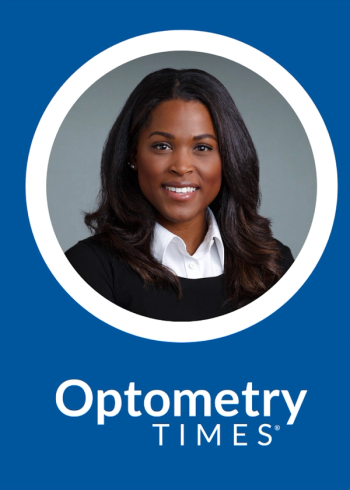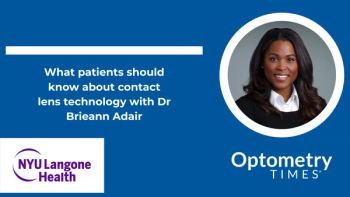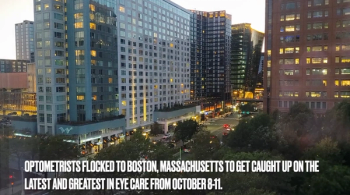
Contact lenses will do more than correct refractive error
Contact lenses have more to offer than only refractive error correction
Gretchyn Bailey: Hello, I'm Gretchyn Bailey with Optometry Times®. And I am sitting here today with Dr. Lyndon Jones, who is the director of the Centre for Ocular Research & Education or CORE at the University of Waterloo. Lyndon, thanks so much for talking with me today.
Lyndon Jones, PhD, FCAHS, FCOptom, FAAO: You’re welcome, Gretchyn. Thanks for the opportunity to have a chat.
Bailey: Well, I understand that there is some new research out that you are part of that is talking about contact lenses, and how we can do a whole lot more than slapping on some corneas to correct refractive error. So, some of these things we might have talked about a little bit, some of them aren’t so new, but some of them are very new. Can you tell me a little bit about what this research is?
Jones: Yeah. So, this basically comes out of a
But one of those papers looks at something really quite different. And that is the potential future opportunities for contact lenses beyond, as you just said, correcting refractive error. There are a lot of opportunities now around because of things like nanotechnology and miniaturization that enabled us to look at great opportunities for contact lenses moving forward.
Bailey: Can you give me a little detail on some of these about such as if we’re doing disease detection? Or if we are looking at nanotechnology? How would that apply? And what will this mean for ODs after these products come to market?
Jones: Yeah, great, great questions. So, basically, if we are looking at the potential feature options, there are three major areas.
Disease detection
Jones: The first is in the detection of disease. Now, we already have a commercially available device, the Triggerfish, which measures the intraocular pressure using a strain gauge. It has an onboard variety of electronics, which measure the pressure within your eye, off-board that information to a little recorder that you wear around your neck, and give you cycling of your intraocular pressure over a long period of time. So, that is already commercially available, dealt by a Swiss company; it has FDA approval.
Because of those kinds of technologies, we are now looking at other ways of being able to detect disease as well. And that is covered in this review paper. Some of the things that will be very interesting relate to things like sensing analytes within the tear film to look for things like diabetes, so glucose monitoring of the tear film. And people have been trying to do that for quite some time.
But now we have a much better way of being able to do that, even things that, again, seem almost impossible to do. Things like detecting biomarkers related to cancer; there are a number of biomarkers that are elevated within the tear film if you have certain types of cancer throughout your body. Through nanotechnology, the contact lens can detect those and offboard that information to warn you if those have been elevated in your tear film.
Another area relates to things like dry eye disease. Again, we know that dry disease has a large amount of inflammatory components related to it. Some of these contact lens materials now soak up some of those inflammatory mediators and tell us if those have been elevated as well. So that is the first area; it relates to detection of disease.
Disease management
Jones: The next one, which I think is exciting for optometry, relates to the management of disease. So imagine if you had a contact lens that could deliver to your eye, over an extended period of time, a particular drug to treat a disease. Typically at the moment, if we're looking to treat a disease, the way that we do that, of course, is by using drops.
Drops are not a great way of managing disease. First of all, patients have to remember to put them in. Secondly, when they do put them in, often they don’t put them in very well. There is a lot of overspill. And thirdly, they drain off the ocular surface really quickly. You know, most drugs last only around about 20 minutes or so.
So what would be ideal is to take a contact lens, loadit up with a drug, put it on your eye, have it controlled such that the drug elutes from the lens over a period of time, whether that be over a day or ideally over maybe a week or so. Now again, it sounds like science fiction. It’s not. In fact, interestingly, just this week, we heard that Johnson & Johnson have through their Theravision lens actually had exactly that concept approved in Japan.
Bailey: Good timing for your paper.
Jones: Thanks, J&J, for waiting for our paper to come out. It is pretty amazing that it’s the same week. But the Theravision lens, for those of you haven’t heard about that yet, again, great concept. Ketotifen, an anti-allergy drug, elutes from the contact lens over a period of a day and helps with those patients who have itchy eyes. So that is a daily disposable lens that releases an anti-allergy component. That is the second great concept.
Optical components
Jones: The third sounds a little bit more futuristic. That is related to the ability of us now to be able to incorporate into contact lenses optical components which can help with things like head-up displays that can be used in patients with low vision so as a magnifying lens of some description and even the potential for artificial intelligence and ways to, for example, read your text without looking at your phone but having it beamed onto your eye. We heard back last year Mojo Vision producing this concept within a contact lens.
Lots of new technology that sounds crazy, but companies are working on this. That is what this paper does—it reviews all of the technology, so for those of you who are interested in these alternative concepts, take a read. The papers free to download from from the BCLA journal.
Bailey: We will include the link below the video so people can click to read it. So, this is all really exciting stuff. Do you have any new information on say, materials? Is that going to be changing coming down the pike? Do you think the materials are going to be changing how these things are adapted or incorporated. Are we looking at any of that?
Jones: Well, some of the technologies, because of the fact they have to be kept dry, some of the miniaturization and some of the battery components—the electronic components, for example—it is actually quite difficult to incorporate them into conventional material. Some of those are going to have to be incorporated into things like scleral lenses. So, we are definitely going to see some of these being in a scleral format. Some of them will be in a silicone format that resists water.
We are going to start to see new contact lens technologies not so much in this space but there are some future exciting materials that contact lens companies are working on that primarily look at driving that great problem with contact lenses, of course: discomfort. We are seeing more and more projects being looked at to improve comfort, particularly toward the end of the day. We will see that coming in in the next couple of years, for sure. Not so much in this space, but again, more broadly because that will help with the contact lens market as well.
Bailey: This sounds really exciting, Lyndon. Thank you so much for taking the time to talk with me.
Jones: You’re very welcome. Thanks a lot.
Newsletter
Want more insights like this? Subscribe to Optometry Times and get clinical pearls and practice tips delivered straight to your inbox.
















































.png)


